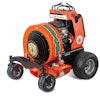
When Hogue Landscape Service’s client originally met with a landscape architect from a different company, Carl Walsh, landscape consultant at Hogue Landscape Services, could tell she was not on board with the plan.
“As we’re walking around, (the architect) had a plan of how he wanted to do things, but I was watching the expressions of the client,” Walsh says. “The architect wasn’t paying attention because he made a beautiful drawing, so when he got done talking, I started asking the client questions.”
After a series of back-and-forth questions and discussing examples, the client decided she wanted the property to evoke scenes from the jungle.
“The landscapes were really simple. They had what we call monkeygrass and crepe myrtles and maybe a boulder, but it was all very simple,” Walsh says. “She said, ‘yes, that’s exactly what I want.’”
To start, Walsh suggested moving existing plant material to other locations to help fill in, before enhancing and adding.
Because the client thought some of the beds were too busy, Hogue also transitioned some of those beds to regular lawn areas.
The only area of the property that can’t be described as “free form” involves two rows of 15-gallon hedges that create a very uniform and structured house and a row of azaleas along the house.
“She has a beautiful brick and iron fence going across the front of her property, and on the inside of the fence was a hedgerow and on the outside of the fence was just plain,” Walsh says. “We installed full-to-the-ground Eagleston Hollies on the inside and on the outside. She wanted it to be very private.”
From there, Hogue ripped out a synthetic turf and gravel area where a trampoline had been from previous owners and started bringing in trees and shrubs that looked like they’d been there for 20 years and planted nearly 2000 to 3000 gallons of monkeygrass.
“There were areas that were already full, and the horticulturalist in me thought it wasn’t a great idea, but it gave her the instant gratification look,” Walsh says.
However, perhaps the biggest challenge was trying to figure out how to fit trees (5-foot-diameter ball and burlap trees) through a 3.5-foot gate and parking the truck and trailer around a 45-degree bend.
While Walsh jokes that he was ready to call in a helicopter if they couldn’t find a solution, a friend of his (David Marks from Environmental Design) convinced him that a crane was the way to go.
Using a crane for two days, crews steered it up the curvy driveway, positioned the crane in the motor court and then lifted the trees up over the house and the neighbor's house in order to get them into the back. They then lifted a forklift up over the wall and up over the house to sit in the back of move the trees once they got on the other side of the wall. Overall, the company incorporated large magnolias, redbuds and around 150 bamboos, ranging from 35 to 60 gallons in size, in addition to about 12 tons of boulders.
“You’re looking at a tree that’s being lifted up 60 feet in the air being turned around a dropped 30 feet away from you, but that’s what we had to do to get it on the other side of the wall,” Walsh says. “They went one by one like that for all the trees.”
The entire project took place over a year-and-a-half, with no more than five crew members on-site at a time performing close to $2 million of work. In addition to the crane and forklift, crews used a Bobcat Dingo to get the bamboo situated in the corners, but everything else was done by wheelbarrow and tree dolly.
Since completing the project, Hogue Landscape Services also performs maintenance services for the property.
For other landscape companies completing projects of this scale, Walsh recommends they keep the client involved as much as possible.
“It’s good to get as much information out of the client as possible, but you also have to be able to educate your client (on what will and will not work) but still give them the look they’re going after,” Walsh says. “I’ve had the opportunity to be around people who want to create things that are different, asking me to create something that’s not cookie cutter. You get to the point where you realize each client is different.”





















